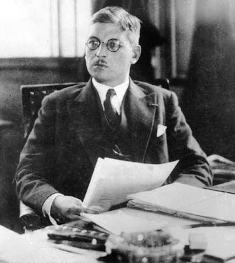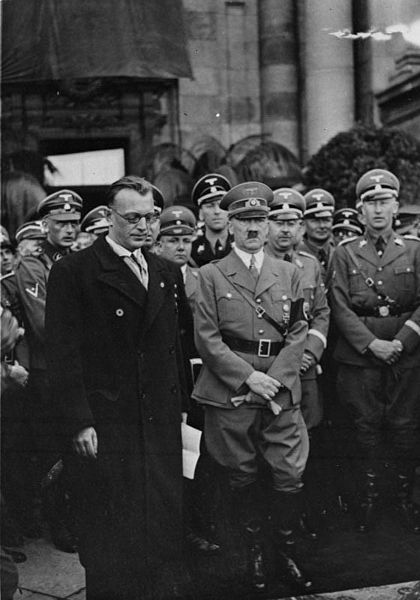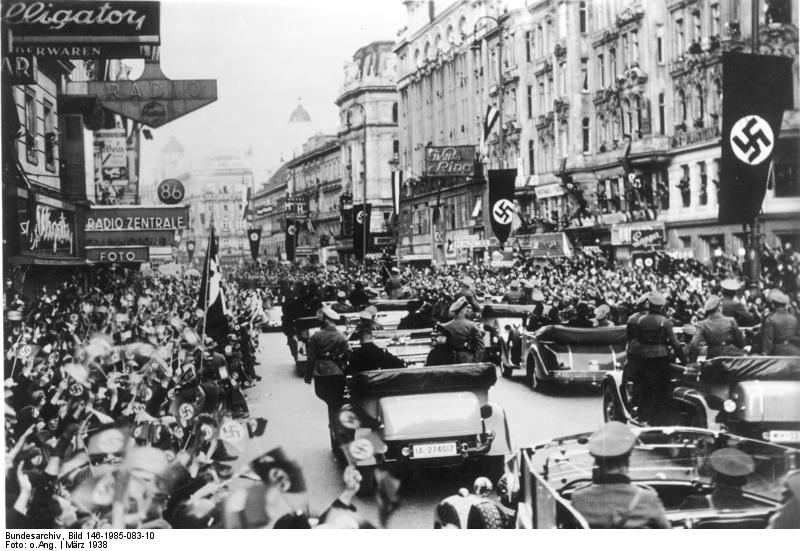<Back to Index>
- Chancellor of Austria Kurt Alois Josef Johann Schuschnigg, 1897
- Composer Jan Antonín Koželuh, 1738
- King of the Hellenes Paul, 1901
PAGE SPONSOR

Kurt Alois Josef Johann Schuschnigg (until 1919 Kurt Alois Josef Johann Edler von Schuschnigg, 14 December 1897 – 18 November 1977) was Chancellor of the First Austrian Republic, following the assassination of his predecessor, Dr. Engelbert Dollfuss, in July 1934, until Germany’s invasion of Austria (Anschluss), in March 1938. He was opposed to Hitler’s ambitions to absorb Austria into the Third Reich. After his efforts to keep Austria independent had failed he resigned his office. After the invasion he was arrested by the Germans, kept in solitary confinement and eventually interned in various concentration camps. He was liberated in 1945 by the advancing American Army and spent most of the rest of his life in academia in the United States.
Schuschnigg came into a Tyrolean family of Carinthian Slovenian descent. The spelling of the family name in Slovenian is Šušnik. Schuschnigg was born in Riva del Garda, now in Trentino, Italy, but then part of Austria - Hungary. He was the son of the Austrian General Artur von Schuschnigg. The young Schuschnigg received his education at the Stella Matutina Jesuit College in Feldkirch. During the First World War he was taken prisoner by the Italians who held him captive until September 1919. Subsequently, after graduating from Innsbruck University he practiced as a lawyer in Innsbruck.
Schuschnigg joined the right wing Christian Social Party and was elected to the Nationalrat in 1927. In 1932 Dollfuss appointed him his Minister of Justice and later Minister of Education. After Dollfuss was assassinated, Schuschnigg was appointed Chancellor and he continued to govern by dictate. His policies were not much different from the policies of his predecessor. He had to manage the economy of a near bankrupt state, had to maintain law and order in a country which was forbidden by the terms of the 1919 Peace Agreement to maintain an army in excess of 30,000 men and at the same time had to cope with armed paramilitary forces in Austria, which owed their allegiance not to the state but to various rival political parties, and he also had to be mindful of the growing strength of the national socialists (Nazis) within the country, who supported Hitler’s ambitions to absorb Austria into the Third Reich. His overriding political concern was how to preserve Austria’s independence within the borders imposed on it by the terms of the 1919 Peace Treaty. His policy of counterbalancing the German threat by aligning himself with Austria’s southern and eastern neighbors, Italy and Hungary, was doomed to failure after Hitler’s ascendance and the increasing military might of the Third Reich. He adopted a policy of appeasement toward Hitler. In July 1936 he signed the Austro - German Agreement, which, among other concessions, allowed the release of Nazis imprisoned in Austria and the inclusion of National Socialists in his Cabinet. However, the National Socialists gained ground in Austria and relations between the two countries deteriorated further.
On 12 February 1938, Schuschnigg met Hitler at Berchtesgaden in an attempt to smooth the worsening relations between their two countries. To Schuschnigg‘s surprise, Hitler presented him with a set of demands which, in manner and in terms, amounted to an ultimatum, effectively demanding the handing over of power to the Austrian National Socialists. The terms of the agreement, presented to Schuschnigg for immediate endorsement, stipulated the appointment of Arthur Seyss - Inquart as minister of security and Dr Hans Fischböck as minister of finance to prepare for economic union between Germany and Austria. A hundred officers were to be exchanged between the Austrian and the German armies. All imprisoned Nazis were to be amnestied and reinstated. In return Hitler would publicly reaffirm the treaty of 11 July 1936 and Austria’s national sovereignty. “The Fuhrer was abusive and threatening, and Schuschnigg was presented with far reaching demands…” According to Schuschnigg’s memoirs, he was coerced into signing the ‘Agreement’ before leaving Berchtesgaden. The key clause in the memorandum was the appointment of the National Socialist Dr. Seyss - Inquart to the post of Minister of Public Security, with full and unlimited control of the police forces in Austria. The President, Dr. Wilhelm Miklas, was reluctant to endorse the Agreement but eventually he did so. Then he, Schuschnigg and a few key Cabinet members considered a number of options:
- 1. the Chancellor resign and the President call on a new Chancellor to form a Cabinet, which would be under no obligation to the commitments of Berchtesgaden.
- 2. The Berchtesgaden agreement be carried out under a newly appointed Chancellor.
- 3. The agreement be carried out and the Chancellor remain at his post.
In the event, they decided to go with the third option.
On the following day, February 14, Schuschnigg reorganized his Cabinet on a broader basis and included representatives of all former and present political parties. Hitler immediately appointed a new Gauleiter for Austria, a Nazi Austrian army officer who had just been released from prison in accordance with the terms of the general amnesty stipulated by the Berchtesgaden agreement.
On 20 February, Hitler made a speech before the Reichstag which was broadcast live and which for the first time was relayed also by the Austrian broadcasting network. A key phrase in the speech was: “… The German Reich is no longer willing to tolerate the suppression of ten million Germans across its borders.”
In Austria the speech was met with concern and by demonstrations by both pro and anti - Nazi elements. On the evening of 24 February, the Austrian Federal Diet was called into session. In his speech to the Diet Schuschnigg referred to the July 1936 agreement with Germany and stated that “…Austria will go thus far and no further.” The speech was received by disapproval from the Austrian Nazis and they began mobilizing their supporters. The headline in The Times of London was "Schuschnigg’s Speech – Nazis Disturbed." The German press found the phrase “Thus far and no further” ‘disturbing’.
To resolve the political uncertainty in the country and to convince Hitler and the rest of the world that the people of Austria wished to remain Austrian and independent of the Third Reich, Schuschnigg, with the full agreement of the President and other political leaders, decided to proclaim a plebiscite to be held on 13 March. But the wording of the referendum which had to be responded to with a ‘Yes’ or a ‘No’ turned out to be controversial. It read:
"Are you for a free, German, independent and social, Christian and united Austria, for peace and work, for the equality of all those who affirm themselves for the people and Fatherland?"
But there was another issue which drew the ire of the National Socialist. Although members of Dr Schuschnigg’s party (the Fatherland Front) could vote at any age, all other Austrians below the age of 24 were to be excluded under a clause to that effect in the Austrian Constitution. This would shut out from the polls most of the Nazi sympathizers in Austria, since the movement was strongest among the young.
The German reaction to the announcement was swift. First Hitler insisted that the plebiscite be cancelled. When Schuschnigg reluctantly agreed to scrap it, Hitler insisted that Seyss - Inquart be appointed Chancellor. This demand President Miklas was reluctant to endorse but eventually, under the threat of immediate armed intervention, this too was endorsed, Schuschnigg resigned on 11 March and Seyss - Inquart was appointed Chancellor, but it made no difference – German troops flooded into Austria and were received everywhere by enthusiastic and jubilant crowds. When, on the morning after the invasion, the London Daily Mail’s correspondent asked the new Chancellor, Seyss - Inquart, how these stirring events came about he received the following reply: “The Plebiscite that had been fixed for tomorrow was a breach of the agreement which Dr. Schuschnigg made with Herr Hitler at Berchtesgaden, by which he promised political liberty for National Socialists in Austria.” On 12 March 1938 Schuschnigg was placed under house arrest.
For a transcript of telephone conversations on 11 March 1938 between Goering and Seyss - Inquart and other Nazis in Vienna concerning various procedural aspects of the Anschluss, found by the Allies in the ruins of the Reichkanzlei in Berlin, see the Appendix in Schuschnigg’s Austrian Requiem.
After initial house arrest followed by solitary confinement at Gestapo Headquarters he spent the remainder of the war in two different concentration camps, Dachau and Sachsenhausen. In late April 1945 Schuschnigg was, together with other prominent concentration camp inmates, transferred to Tyrol where the SS guards abandoned the prisoners. He was liberated by American troops on May 5, 1945.
After World War II, Schuschnigg emigrated to the United States, where he worked as a professor of political science at Saint Louis University from 1948 to 1967.
In 1959 he lost his second wife, Vera Fugger von Babenhausen née Countess
Czernin, whom he married by proxy in Vienna on the 1st June 1938. His
first wife had perished in a car accident on 13 June 1935. Schuschnigg
died at Mutters, near Innsbruck, in 1977.

